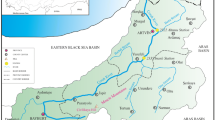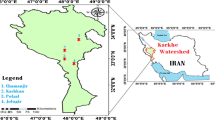Abstract
There is a need to develop an accurate and reliable model for predicting suspended sediment load (SSL) because of its complexity and difficulty in practice. This is due to the fact that sediment transportation is extremely nonlinear and is directed by numerous parameters such as rainfall, sediment supply, and strength of flow. Thus, this study examined two scenarios to investigate the effectiveness of the artificial neural network (ANN) models and determine the sensitivity of the predictive accuracy of the model to specific input parameters. The first scenario proposed three advanced optimisers—whale algorithm (WA), particle swarm optimization (PSO), and bat algorithm (BA)—for the optimisation of the performance of artificial neural network (ANN) in accurately predicting the suspended sediment load rate at the Goorganrood basin, Iran. In total, 5 different input combinations were examined in various lag days of up to 5 days to make a 1-day-ahead SSL prediction. Scenario 2 introduced a multi-objective (MO) optimisation algorithm that utilises the same inputs from scenario 1 as a way of determining the best combination of inputs. Results from scenario 1 revealed that high accuracy levels were achieved upon utilisation of a hybrid ANN-WA model over the ANN-BA with an RMSE value ranging from 1 to 6%. Furthermore, the ANN-WA model performed better than the ANN-PSO with an accuracy improvement value of 5–20%. Scenario 2 achieved the highest R2 when ANN-MOWA was introduced which shows that hybridisation of the multi-objective algorithm with WA and ANN model significantly improves the accuracy of ANN in predicting the daily suspended sediment load.











Similar content being viewed by others
Abbreviations
- ANN:
-
artificial neural network
- WA:
-
whale algorithm
- BA:
-
bat algorithm
- PSO:
-
particle swarm algorithm
- SSL:
-
suspended sediment load
- RMSE:
-
root mean square error
- SVM:
-
support vector machine
- ANFIS:
-
adaptive neurofuzzy interface system
- GP:
-
genetic programming
- WLSSVM:
-
wavelet least square support vector machine
- RBFNN:
-
radial basis function neural network
- FFNN:
-
feedforward neural network
- SSC:
-
suspended sediment concentration
- MLP:
-
multilayer perceptron
- WOA:
-
whale optimisation algorithm
- NDA:
-
non-dominated
- AR:
-
archive
- PF:
-
Pareto front
- MAE:
-
mean absolute error
- PS:
-
population size
- MAF:
-
maximum frequency
- MAL:
-
maximum loudness
- MIL:
-
minimum loudness
- NSE:
-
Nash-Sutcliff efficiency
- RSR:
-
the RMSE observation standard ratio
- PBIAS:
-
percent bias
References
Abba SI, Pham QB, Saini G, et al (2020) Implementation of data intelligence models coupled with ensemble machine learning for prediction of water quality index. Environ Sci Pollut Res 1–16. https://doi.org/10.1007/s11356-020-09689-x
Adib A, Mahmoodi A (2017) Prediction of suspended sediment load using ANN GA conjunction model with Markov chain approach at flood conditions. KSCE J Civ Eng 21:447–457. https://doi.org/10.1007/s12205-016-0444-2
Adnan RM, Liang Z, El-Shafie A et al (2019) Prediction of suspended sediment load using data-driven models. Water (Switzerland) 11. https://doi.org/10.3390/w11102060
Afan HA, El-Shafie A, Yaseen ZM et al (2014) ANN based sediment prediction model utilizing different input scenarios. Water Resour Manag 29:1231–1245. https://doi.org/10.1007/s11269-014-0870-1
Al-Mukhtar M (2019) Random forest, support vector machine, and neural networks to modelling suspended sediment in Tigris River-Baghdad. Environ Monit Assess 191:1–12. https://doi.org/10.1007/s10661-019-7821-5
Aydin O, Gozde H, Dursun M, Cengiz Taplamacioglu M (2019) Comparative parameter estimation of single diode PV-cell model by using sine-cosine algorithm and whale optimization algorithm. Proc - 2019 6th Int Conf Electr Electron Eng ICEEE 2019:65–68. https://doi.org/10.1109/ICEEE2019.2019.00020
Banadkooki FB, Ehteram M, Ahmed AN, Fai CM, Afan HA, Ridwam WM, Sefelnasr A, el-Shafie A (2019) Precipitation forecasting using multilayer neural network and support vector machine optimization based on flow regime algorithm taking into account uncertainties of soft computing models. Sustainability 11:6681. https://doi.org/10.3390/su11236681
Banadkooki FB, Ehteram M, Ahmed AN, et al (2020) Suspended sediment load prediction using artificial neural network and ant lion optimization algorithm. Environ Sci Pollut Res 1–23. https://doi.org/10.1007/s11356-020-09876-w
Bozorg-Haddad O, Karimirad I, Seifollahi-Aghmiuni S, Loáiciga HA (2015) Development and Application of the Bat Algorithm for Optimizing the Operation of Reservoir Systems. J Water Resour Plan Manag 141:04014097. https://doi.org/10.1061/(ASCE)WR.1943-5452.0000498
Chen XY, Chau KW (2016) A hybrid double feedforward neural network for suspended sediment load estimation. Water Resour Manag 30:2179–2194. https://doi.org/10.1007/s11269-016-1281-2
Dar AA, Anuradha N (2018) An application of Taguchi L9 method in Black-Scholes model for European call option. Int J Entrep 22
Ehteram M, Othman FB, Yaseen ZM et al (2018) Improving the Muskingum flood routing method using a hybrid of particle swarm optimization and bat algorithm. Water (Switzerland) 10:1–21. https://doi.org/10.3390/w10060807
Ehteram M, Ahmed AN, Fai CM, Afan HA, el-Shafie A (2019a) Accuracy enhancement for zone mapping of a solar radiation forecasting based multi-objective model for better management of the generation of renewable energy. Energies 12. https://doi.org/10.3390/en12142730
Ehteram M, Ghotbi S, Kisi O et al (2019b) Investigation on the potential to integrate different artificial intelligence models with metaheuristic algorithms for improving river suspended sediment predictions. Appl Sci 9:1–24. https://doi.org/10.3390/app9194149
Ehteram M, Ahmed AN, Ling L, Fai CM, Latif SD, Afan HA, Banadkooki FB, el-Shafie A (2020) Pipeline scour rates prediction-based model utilizing a multilayer perceptron-colliding body algorithm. Water (Switzerland). 12. https://doi.org/10.3390/w12030902
Emamgholizadeh S, Demneh RK (2018) A comparison of artificial intelligence models for the estimation of daily suspended sediment load: a case study on the Telar and Kasilian rivers in Iran. Water Sci Technol Water Supply 19:165–178. https://doi.org/10.2166/ws.2018.062
Fazelzadeh M, Karbassi AR, Mehrdadi N (2012) An investigation on the role of flocculation processes in geo-chemical and biological cycle of estuary (case study: Gorganrood river). Int J Environ Res 6:391–398. https://doi.org/10.22059/ijer.2012.506
Ghose DK, Samantaray S (2019) Computational intelligence in sensor networks. Springer, Berlin Heidelberg
Jaiyeola AT, Adeyemo J (2019) Performance comparison between genetic programming and sediment rating curve for suspended sediment prediction. African J Sci Technol Innov Dev 11:843–859. https://doi.org/10.1080/20421338.2019.1587908
Kakaei Lafdani E, Moghaddam Nia A, Ahmadi A (2013) Daily suspended sediment load prediction using artificial neural networks and support vector machines. J Hydrol 478:50–62. https://doi.org/10.1016/j.jhydrol.2012.11.048
Kaveh K, Duc Bui M, Rutschmann P (2017) A comparative study of three different learning algorithms applied to ANFIS for predicting daily suspended sediment concentration. Int J Sediment Res 32:340–350. https://doi.org/10.1016/j.ijsrc.2017.03.007
Melesse AM, Ahmad S, McClain ME et al (2011) Suspended sediment load prediction of river systems: an artificial neural network approach. Agric Water Manag 98:855–866. https://doi.org/10.1016/j.agwat.2010.12.012
Mirjalili S, Dong JS, Lewis A, Reviews L (2020a) Nature-Inspired Optimizers. Springer International Publishing
Mirjalili S, Mirjalili SM, Saremi S, Mirjalili S (2020b) Whale optimization algorithm: Theory, literature review, and application in designing photonic crystal filters. In: Studies in Computational Intelligence. Springer Verlag, pp 219–238
Mirjalili S, Song Dong J, Lewis A, Sadiq AS (2020c) Particle swarm optimization: Theory, literature review, and application in airfoil design. In: Studies in Computational Intelligence. Springer Verlag, pp 167–184
Moeeni H, Bonakdari H (2018) Impact of normalization and input on ARMAX-ANN model performance in suspended sediment load prediction. Water Resour Manag 32:845–863. https://doi.org/10.1007/s11269-017-1842-z
Moriasi DN, Arnold JG, Van Liew MW et al (2007) Model evaluation guidelines for systematic quantification of accuracy in watershed simulations. Trans ASABE 50:885–900. https://doi.org/10.13031/2013.23153
Najah Ahmed A, Binti Othman F, Abdulmohsin Afan H, Khaleel Ibrahim R, Ming Fai C, Shabbir Hossain M, Ehteram M, Elshafie A (2019) Machine learning methods for better water quality prediction. J Hydrol 578:124084. https://doi.org/10.1016/j.jhydrol.2019.124084
Najah A, El-Shafie A, Karim OA, Jaafar O (2011) Integrated versus isolated scenario for prediction dissolved oxygen at progression of water quality monitoring stations. Hydrol Earth Syst Sci 15:2693–2708. https://doi.org/10.5194/hess-15-2693-2011
Nourani V, Andalib G (2015) Daily and monthly suspended sediment load predictions using wavelet based artificial intelligence approaches. J Mt Sci 12:85–100. https://doi.org/10.1007/s11629-014-3121-2
Nourani V, Alizadeh F, Roushangar K (2016) Evaluation of a two-stage SVM and spatial statistics methods for modeling monthly river suspended sediment load. Water Resour Manag 30:393–407. https://doi.org/10.1007/s11269-015-1168-7
Ramalingam K, Kandasamy A, Balasubramanian D, Palani M, Subramanian T, Varuvel EG, Viswanathan K (2019) Forecasting of an ANN model for predicting behaviour of diesel engine energised by a combination of two low viscous biofuels. Environ Sci Pollut Res. 27:24702–24722. https://doi.org/10.1007/s11356-019-06222-7
Rashidi S, Vafakhah M, Lafdani EK, Javadi MR (2016) Evaluating the support vector machine for suspended sediment load forecasting based on gamma test. Arab J Geosci 9. https://doi.org/10.1007/s12517-016-2601-9
Shamaei E, Kaedi M (2016) Suspended sediment concentration estimation by stacking the genetic programming and neuro-fuzzy predictions. Appl Soft Comput J 45:187–196. https://doi.org/10.1016/j.asoc.2016.03.009
Talebi A, Mahjoobi J, Dastorani MT, Moosavi V (2016) Estimation of suspended sediment load using regression trees and model trees approaches (case study: Hyderabad drainage basin in Iran). ISH J Hydraul Eng 23:212–219. https://doi.org/10.1080/09715010.2016.1264894
Teo FY, Chun Kiat C, Ab Ghani A, Zakaria NA (2017) River sand mining capacity in Malaysia. Proc 37th IAHR WORLD Congr
Tey KS, Mekhilef S, Seyedmahmoudian M (2018) Implementation of BAT algorithm as maximum power point tracking technique for photovoltaic system under partial shading conditions. 2018 IEEE Energy Convers Congr Expo ECCE 2018 2531–2535. https://doi.org/10.1109/ECCE.2018.8557460
Tikhamarine Y, Souag-Gamane D, Najah Ahmed A, Kisi O, el-Shafie A (2020) Improving artificial intelligence models accuracy for monthly streamflow forecasting using grey Wolf optimization (GWO) algorithm. J Hydrol 582:124435. https://doi.org/10.1016/j.jhydrol.2019.124435
Valikhan-Anaraki M, Mousavi S-F, Farzin S, Karami H, Ehteram M, Kisi O, Fai CM, Hossain MS, Hayder G, Ahmed AN, el-Shafie AH, Bin Hashim H, Afan HA, Lai SH, el-Shafie A (2019) Development of a novel hybrid optimization algorithm for minimizing irrigation deficiencies. Sustainability 11:2337. https://doi.org/10.3390/su11082337
Yaseen ZM, Allawi MF, Karami H, Ehteram M, Farzin S, Ahmed AN, Koting SB, Mohd NS, Jaafar WZB, Afan HA, el-Shafie A (2019) A hybrid bat–swarm algorithm for optimizing dam and reservoir operation. Neural Comput Appl 31:8807–8821. https://doi.org/10.1007/s00521-018-3952-9
Acknowledgements
The authors would like to appreciate the financial support received from the Institute of Postgraduate Studies and Research (IPSR) of Universiti Tunku Abdul Rahman.
Author information
Authors and Affiliations
Corresponding author
Ethics declarations
Conflict of interest
The authors declare that there is no conflict of interest.
Additional information
Responsible Editor: Marcus Schulz
Publisher’s note
Springer Nature remains neutral with regard to jurisdictional claims in published maps and institutional affiliations.
Rights and permissions
About this article
Cite this article
Ehteram, M., Ahmed, A.N., Latif, S.D. et al. Design of a hybrid ANN multi-objective whale algorithm for suspended sediment load prediction. Environ Sci Pollut Res 28, 1596–1611 (2021). https://doi.org/10.1007/s11356-020-10421-y
Received:
Accepted:
Published:
Issue Date:
DOI: https://doi.org/10.1007/s11356-020-10421-y




